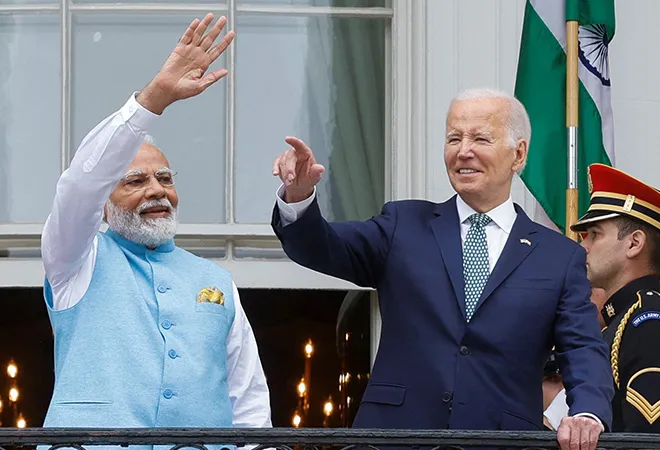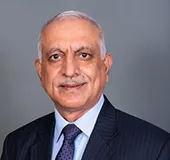-
CENTRES
Progammes & Centres
Location
There is a genuine desire on both sides to rapidly transform their defence partnership, but only time will tell if this intent translates into concrete outcomes

The state visit of the Indian Prime Minister, Narendra Modi, to the United States (US) from 21–23 June evoked unprecedented excitement, commentary, and coverage in both countries. The majority appeared to hail it as a ‘major turning point’ and the ‘most consequential visit’ for the bilateral relationship. Overall, the visit appeared to inject new energy and dynamism, heightened optimism, and a fresh approach that is more relevant for the current times. Defence and technology cooperation was at the front and centre and dominated the debate in the run-up to, and during, the visit. While defence cooperation remained the ‘main pillar’ and a ‘key driver’ of the India-US strategic partnership, the focus this time was different; there was a sense of urgency for rapid acceleration.
The post-Cold War India-US defence cooperation, initiated in the mid-1990s, gained good momentum in the first decade of this century. The Next Steps in Strategic Partnership (NSSP), the Defence Framework Agreement, the institutionalised meetings and reviews under the Defence Policy Group (DPG) and associated groups, enabled early harvest of some low-hanging fruit. Exercises, visits, training, dialogues and seminars increased in frequency and depth. Defence procurements started from the US, both through Direct Commercial Sales (DCS) and Foreign Military Sales (FMS). The second decade of this century saw a new effort by both sides to elevate the defence cooperation to the next level. The series of steps included the Defence Trade and Technology Initiative (DTTI), the Joint Declaration on Defence Cooperation, the signing of ‘foundational agreements’ after prolonged deliberations, and the US announcement of India as a “Major Defence Partner”. The objectives included defence technology transfers, licencing and regulatory facilitation, increased defence trade, research partnerships, and movement towards co-production and co-development. A two-plus-two dialogue (with Defence and Foreign Ministers/Secretaries from both sides) was established. While defence procurements picked up momentum, the progress on defence technology, research, and production collaboration remained tardy, which made some of these frameworks look high on promise and low on delivery.
Both countries recognise that common challenges are going to be very different from those in the first two decades, necessitating rapid adaptation and overcoming of hurdles experienced in the past.
In the last two decades, the defence cooperation between India and the US has not only been central to their broader bilateral partnership but has also been a key enabler for stronger collaboration at multilateral and minilateral levels. Both countries recognise that common challenges are going to be very different from those in the first two decades, necessitating rapid adaptation and overcoming of hurdles experienced in the past. Few areas of divergence notwithstanding, the growing defence and security relationship has enabled similar approaches—initially centred on the Indian Ocean and later the broader Indo-Pacific region. The bilateral defence and security relations are being aligned towards common objectives in the Quad. From the end of the last decade, there has also been enhanced cooperation on global issues.
The joint statement issued after the June 2023 visit highlighted that “our cooperation will serve the global good as we work through a range of multilateral and regional groupings – particularly the Quad ….”. It stressed the collaborative approach of both countries towards global governance and global growth. It also highlighted that technology would play a defining role in deepening the partnership. It linked technology sharing with the Strategic Trade Dialogue, launched in the run-up to the visit. The section on defence was appropriately titled ‘Powering a Next Generation Defence Partnership’. The statement also emphasised the current and emerging security threats and condemned cross-border terrorism emanating from some countries.
In the last five years or so, advanced technology competition, including in the defence sector, has become the predominant theme in geopolitics and geoeconomics. By early 2022, both India and the US seemed to have recognised that one of the key reasons for the lack of progress under the DTTI framework and related announcements was the non-existence of an overarching, umbrella framework for technical cooperation. While defence technology cooperation is harder and has its peculiar challenges, it cannot expand at the desired pace in the current environment by operating in a silo. Accordingly, a broader bilateral Initiative on Critical and Emerging Technology (iCET) was announced in May 2022 (and officially launched in Jan 2023). Its pillars include strengthening the innovation ecosystem, defence innovation and technology cooperation, resilient semiconductor supply chains, space, STEM talent, and next-generation telecommunications. Steered by the two National Security Councils, it has multi-agency participation and enables institutional linkages across sectors, departments, agencies, businesses, research organisations, and academia.
The < style="text-decoration: underline">Memorandum of Understanding (MoU) between General Electric and Hindustan Aeronautics Ltd, to manufacture 99 GE F414 jet engines in India as part of the LCA Mk2 programme. was noted in the joint statement as “trailblazing”. After years of negotiations and deliberations, the level of the Transfer of Technology (ToT) is stated to be “greater”, although specifics of this ToT are still not available in the public domain. The level of involvement of the Indian side towards the prototype development and testing of the new F414-INS6 engine for the AMCA programme is also not clear yet.
Private sector participation in defence R&D is also very low in India and needs to be enhanced, with a suitable balance with R&D expenditure by the DRDO.
To fully capitalise and leverage the India-US defence technology cooperation, the US agencies will need to match commitments of technology sharing and collaboration with concrete and timely actions. On the other hand, India will need to step up its efforts to significantly improve outcomes in its own defence technology programmes and ecosystem, for which it has excellent potential. Currently, the US spends 13 percent of its defence budget on R&D, while India spends only around one percent. Private sector participation in defence R&D is also very low in India and needs to be enhanced, with a suitable balance with R&D expenditure by the DRDO. In the current scenario, it may require some form of incentivisation by the government for the defence private sector, for R&D in specific areas. It is also important to recognise the limits of defence technology sharing. ToT in critical areas is indeed useful but should not be seen as an end by itself. If ToT is not leveraged to leapfrog in specific and related areas, a country can remain caught up in a never-ending cycle of seeking ToT, with heavy payments on each occasion. The new Indian approach seeks to correct the serious shortcomings in assimilation and appropriate utilisation of ToT in the past.
A new defence industrial cooperation roadmap was adopted during the visit, to enable co-production of advanced defence systems, and collaborative research, testing, and prototyping of projects. Both countries will work to identify immediate and high-impact opportunities to cooperatively produce the systems required to meet India’s military modernisation objectives. The US will support India in the creation of logistic, repair, and maintenance infrastructure for aircraft and ships. The focus areas have been indicated as ISR, undersea domain awareness, air combat and aero-engines, munitions, and mobility. The GE-HAL MoU can be considered the first programme aligned with this roadmap. However, additional specific programmes will need to be launched and implemented to make the roadmap effective on the ground.
As part of the FMS procurement of 31 MQ-9B UAVs—which will be assembled in India—a comprehensive global Mantainence, Repair and Overhaul (MRO) facility will also be established by General Atomics in India. Other than ISR capability enhancement through this purchase, this facility will further boost the rapidly emerging MRO business and ecosystem (both defence and civil) in India.
A new collaboration agenda was announced, which would include joint prize challenges for start-ups, roundtable events, mentor-protégé initiatives between major primes and start-ups, and the formation of a Senior Advisory Group.
The India-US Defence Acceleration Ecosystem (INDUS-X) launched during the visit seeks to vitalise the defence industrial cooperation and unlock new innovations in technology and manufacturing. A new collaboration agenda was announced, which would include joint prize challenges for start-ups, roundtable events, mentor-protégé initiatives between major primes and start-ups, and the formation of a Senior Advisory Group. INDUS-X can provide a further boost to the highly successful Indian defence programme named Innovation for Defence Excellence (IDEX), and the SPRINT challenge series, which has now been initiated in the Space sector too. Of particular significance will be the connection between major primes and start-ups that can create opportunities to scale innovations as also embed numerous innovations into larger platforms and systems. No financial outlay has been indicated for the programme at present. Interestingly, the INDUS-X announcement also mentioned its potential contribution to promoting global peace, security and prosperity, and towards a Free and Open Indo-Pacific.
It is likely that in due course, INDUS-X would be extended to become a QUAD programme with a suitable acronym, as the building blocks for the same are already in place.
The key takeaways from the visit, related to the defence sector, can be summarised below:
There is a genuine desire and common consensus on both sides to rapidly and emphatically transform their defence partnership, in line with the vastly different strategic environment of the third decade of this century. It is apparent that unusually substantial preparatory work had been done prior to the visit. The new frameworks and arrangements announced are ambitious and seek to address the shortcomings and hurdles experienced in the last decade.
Technology cooperation is central to transforming the relationship. In addition to the bilateral frameworks announced, both sides will also need to look internally to step up the pace of execution. India will need to significantly enhance its defence technology capabilities and make full use of ToT—including through the private sector—to play an increasingly important role in co-development programmes. No major defence co-development programme has been announced yet, which needs to be done in the coming months.
The new frameworks and arrangements announced are ambitious and seek to address the shortcomings and hurdles experienced in the last decade.
More co-production programmes (like aero engines) may be expected, which will benefit both sides. In addition to improvements to the defence industrial base, they will bring significant contributions to make supply chains secure and resilient. Linking defence innovation ecosystems is an excellent step, but more work will be needed to convert promise into delivery in terms of making advanced capabilities available through these efforts.
The India-US defence industrial and technology cooperation also implicates many strands of the current geopolitics and geoeconomics. It aligns itself with the ongoing joint initiatives by the two countries in the Indo-Pacific region through various mechanisms. Some of the initiatives announced during the visit may be expected to lead to similar mechanisms or arrangements under the Quad. There is a clear appreciation that the broader US derisking process vis-à-vis China, in the defence sector, will take time and cannot be done overnight. From an Indian perspective, the visit also aimed to convey that strong defence partnerships and strategic autonomy are not mutually exclusive, and that mature relationships can navigate the delicate balance.
The statement of intent indicated in the joint statement is transformative. Translation of this intent and aspirations into concrete outcomes, in a reasonable timeframe, will make this visit historic.
Vice Admiral Girish Luthra is Distinguished Fellow at the Observer Research Foundation
The views expressed above belong to the author(s). ORF research and analyses now available on Telegram! Click here to access our curated content — blogs, longforms and interviews.

Vice Admiral Girish Luthra is Distinguished Fellow at Observer Research Foundation, Mumbai. He is Former Commander-in-Chief of Western Naval Command, and Southern Naval Command, Indian ...
Read More +